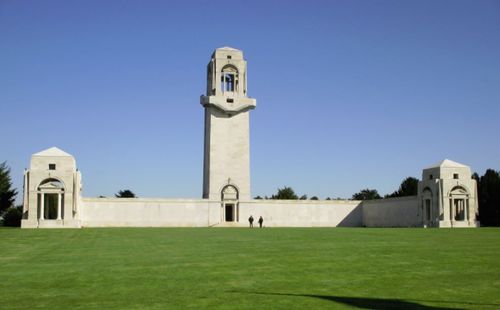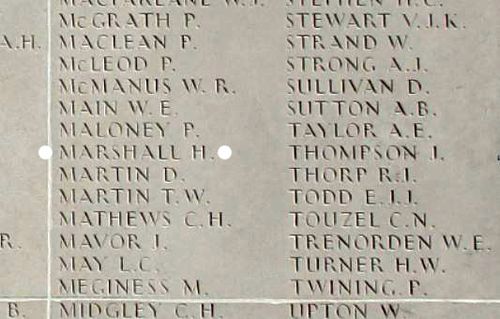Harold V Marshall
From Our Contribution
 | |
| Personal Information | |
|---|---|
| Date of Birth | not known 1893 |
| Place of Birth | South Melbourne, Victoria |
| Death | 9 Aug 1916 |
| Place of Death | near Poziéres, France |
| Age at Enlistment | 22 years, 10 months |
| Description |
5'7¾" (1.m) tall ; 145 lbs 65.771 kg ; fair complexion ; greenish eyes ; reddish hair |
| Occupation | Railway employee |
| Religion | Roman Catholic |
| Address | NOK 191 Nelson road, Alfred Park, Victoria |
| Next of Kin | Sister , Miss Edith Marshall |
| Military Information | |
| Reg Number | 2019 |
| Date of Enlistment | 14 Feb 1915 |
| Rank | Private |
| Unit/Formation | 16th Battalion, 5th Reinforcements, posted to A Company |
| Date of Embarkation | 18 Feb 1915 |
| Ship Embarked On | HMAT A20 Hororata |
| Fate | Died of Wounds 9 Aug 1916 |
| Monument |
Armadale War Memorial (West Armadale panel) Villers-Bretonneux Memorial Armadale and Districts Roll of Honour Australian War Memorial |
| Medals |
1914-15 Star British War Medal Victory Medal |
Contents
Pre War
War Service
Taken on strength by the 16th Battalion at Gallipoli on 13 Jul 1915. On 10 Aug 1915 he reported sick. Harold arrived In Alexandria on 16 Aug 1915 aboard HMHS Neuralia suffering with dysentery. Admitted the same day to the 1st Australian General Hospital before being released to the 1st Australian Auxiliary Hospital on 13 Sep 1915. A week later he was transferred to their Convalescent Depot and returned to duty on 5 Oct 1915.
On 18 Oct 1915 he boarded HMT Kalyan in Alexandria and rejoined his unit on Lemnos on 23 Oct 1915. His record is silent on when he returned to Gallipoli, with the next entry being his arrival back in Alexandria from Mudross Harbour aboard HMAT A11 Ascanius on 30 Dec 1915 which had left Mudros on the 27th. However he is listed in "The Old Sixteenth" [1](with the wrong Reg No 2919) as being a part of the 'A' Echelon of the battalion which was evacuated on the second day i.e. 5:20 pm on 19 Dec 1915.
Ill from either the effects of VD, or from appendicitis (his records shows both), he was admitted to the 1st Australian Stationary Hospital in Ismailia via the 4th Australian Field Ambulance on 27 Jan 1916, before returning to his unit on 1 Feb 1916. The next few months were occupied with the enlargement of the number of Australian units, before on 1 Jun 1916 when the 16th Battalion boarded the HMT Canada for Marseilles in France where it arrived on 7 Jan 1916.
Late on 9 Aug 1916 the battalion moved into the front lines near Poziéres. It was tasked with attacking Circular Trench, midway between Poziéres and Mouquet Farm. They captured their objective by midnight and consolidated before on the 10th being very heavily bombarded by the German artillery. On the 11th the battalion captured some other trenches in their vicinity before facing a full counter attack at 1:40pm on 11 Aug 1916. By soon after 3:00pm the attack had faulted under heavy Australian rifle and machine gun fire. On the morning of 12 Aug 1916 the Australian positions were again subject to very heavy bombardment causing casualties. Later that afternoon they were replaced in the line and returned to the rear pursued by what was described as a vindictive bombardment that followed them all the way.
It is not known when Harold was killed, having been initially reported as wounded and evacuated to the 4th Australian Field Ambulance. However, a written statement made on 14 Apr 1917 by 2190 Pte J Pekin was later grounds for declaring Harold to have been Killed in Action.On the morning of the 9/8/16 I saw the body of 2019 Pte Marshall late of 16th Battalion A.I.F. waiting for burial. I am sure it was he, as he was a personal friend of mine. Harold's Red Cross File provides further insight, with several stories collaborating the same set of facts. A letter from 2264 Cpl Rupert Thorne to Miss Kalman of the Red Cross written for his family in Australia summarises them all.[2].
"No doubt you will be surprised to hear from me and I assure you I do not relish the duty I am performing. You have doubtless been informed by the Authorities of the unfortunate demise of our mutual friend, Pte H. Marshall, and as requested by him before his death I am giving you the particulars as well as I possibly can. The unfortunate incident occurred on the night of 9th August when we were supporting another Battalion that was attacking the German positions in front. Our Company moved up about 9 p.m. after the first two waves of attacking infantry had gone 'over the top'. About this time the Germans put up a counter barrage of artillery fire on our trenches and everything was a whirl of excitement. Shells and dirt were falling all around us, and the parapet was being blown away in many places. Poor old 'Jumbo', as we used to call him, was only some few yards behind me, when a big high explosive shell burst through the parapet, and he was one of those hit. As far as I can remember, it was his arm and ribs that was hurt most, but another Kalgoorlie lad named Smith, a great friend of Jumbo's told me that he was singing when he went down on the stretcher to the dressing station..
As there were a great many casualties this night, and the doctors were very busy, there were naturally a lot of men awaiting attention. That was the real danger, getting men out after they had been hit. He was dressed and waiting with the others until daylight to be carried down. A stretcher bearer of ours who had seen him in the night (Jack Peakin is his name) did not think he was very badly hit, and early next morning he went around the various cases to see whom he knew. One man covered with a blanket attracted his attention, and going over to him, he pulled it aside to see his face, and it was poor old Jumbo. He probably died from shock as much as the loss of blood.
One can do little in cases like this, but Jumbo, as he was affectionately called, was a prime favourite of the platoon, and no one regrets his loss more than I do. He was always a genial, happy go lucky comrade, and everyone who knew him liked and respected him.
I shall endeavour to find out where he is buried, and if you care to know I shall be only too pleased to let you know, providing always of course that I am able to, as one never knows one's luck in this game.
And with many expressions of sympathy and condolences in your sad loss, I shall close and remain. Yours in all sympathy, H Tanquay and R Thorn No 2264 A Coy 16th Battalion.On 19 May 1917 he was finally declared to have been KIA on 8 Aug 1916.
Notes
Connection to the district not established, but he is mentioned in a local newsletter "The Drill of the Foot-Hills"
- ↑ Captain C Longmore, Imperial War Museum
- ↑ "Australian Red Cross Wounded and Missing Files - Harold Marshall". Australian War Memorial. 2018. Retrieved 2 May 2018.

